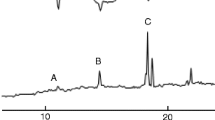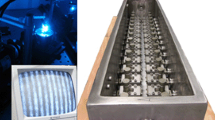Abstract
A method has been developed to predict the release ratio of the components of blends of alcohols, acetates, and/or aldehydes from rubber septa. The calculations of predicted release ratios are based on the relative vapor pressures of the components. The relative vapor pressures of the compounds were calculated from their retention indices on a liquid crystal capillary gas chromatographie column. The correlation between the theoretically predicted and experimentally determined ratios was very good. Thus, formulations can be prepared that will release a desired ratio of the components of a multicomponent pheromone blend.
Similar content being viewed by others
References
Baker, T.C., Cardé, R.T., andMiller, J.R. 1980. Oriental fruit moth pheromone component emission rates measured after collection by glass surface adsorption.J. Chem. Ecol. 4:749–758.
Butler, L. I., andMcDonouoh, L.M. 1979. Insect sex pheromones: Evaporation rates of acetates from natural rubber septa.J. Chem. Ecol. 5:825–837.
Butler, L.I., andMcDonough, L.M. 1981. Insect sex pheromones: Evaporation rates of alcohols and acetates from natural rubber septa.J. Chem. Ecol. 7:627–633.
Grob, K., andZücher, D. 1976. Stripping of organic trace substances from water. Equipment and procedure.J. Chromatogr. 117:285–294.
Heath, R.R., andTumlinson, J.H. 1986. Correlation of retention times on a liquid crystal capillary column with reported vapor pressures and half-lives of compounds used in pheromone formulations.J. Chem. Ecol. 11:2081–2088.
Heath, R.R., Burnsed, G.E., Tumlinson, J.H., andDoolittle, R.E. 1980. Separation of a series of positional and geometrical isomers of olefinic aliphatic primary alcohols and acetates by capillary gas chromatography.J. Chromatogr. 189:199–208.
Heath, R.R., andTumlinson, J.H. 1986. Correlation of retention times on a liquid crystal capillary column with reported vapor pressures and half-lives of compounds used in pheromone formulations.J. Chem. Ecol. 12:2081–2088.
Hiroka, Y., andSuwanai, M. 1978. Role of insect sex pheromones in mating behavior. II. An aspect of sex pheromone as a volatile material.Appl. Entomol. Zool. 11:38–43.
Leonhardt, B.A., andMoreno, P.S. 1982. Evaluation of controlled release laminate dispensors for pheromones of several insect species, pp. 159–173,in B.A. Leonhardt and M.A. Beroza (eds.). Insect Pheromone Technology: Chemistry and Applications. American Chemical Society Symposium Series 190. American Chemical Society, Washington, D.C.
Kydonieus, A.F., andBeroza, M.A. 1982. Insect Suppression with Controlled Release Pheromone Systems. CRC Press, Boca Raton, Florida.
McDonough, L.M., andButler, L.I. 1983. Insect sex pheromones: Determination of half-lives from formulations by collection of emitted vapor.J. Chem. Ecol. 9:1491–1502.
Mitchell, E.R. 1981. Management of Insect Pests with Semiochemicals. Plenum Press, New York.
Olsson, A.M., Jonsson, J.A., Thelin, B., andLiljefors, T. 1983. Determination of the vapor pressures of moth sex pheromone components by a gas chromatographic method.J. Chem. Ecol. 9:375–385.
Regnault, H.V. 1845. Determination of vapor pressure using gas saturation.Ann. Chem. 15:129–134.
Swoboda, P.A.T. 1962. Qualitative and quantitative analysis of flavour volatiles from edible fats, pp. 273–291,in M. van Swaay (ed.). Gas Chromatography 1962. Butterworth, London.
Tumlinson, J.H., Heath, R.R., andTeal, P.E.A. 1982. Analysis of chemical communications systems of Lepidoptera, pp. 1–27,in B.A. Leonhardt and M. Beroza (eds.). Insect Pheromone Technology: Chemistry and Applications. American Chemical Society Symposium Series 190. American Chemical Society, Washington, D.C.
Weatherston, J., Golub, M.A., andBenn, M.H. 1982. Release rates of pheromones from hollow fibers, pp. 146–157,in B.A. Leonhardt and M.A. Beroza (eds.). Insect Pheromone Technology: Chemistry and Applications. American Chemical Society Symposium Series 190. American Chemical Society, Washington, D.C.
Author information
Authors and Affiliations
Additional information
Mention of a commercial or proprietary product does not constitute an endorsement by the USDA.
Rights and permissions
About this article
Cite this article
Heath, R.R., Teal, P.E.A., Tumlinson, J.H. et al. Prediction of release ratios of multicomponent pheromones from rubber septa. J Chem Ecol 12, 2133–2143 (1986). https://doi.org/10.1007/BF01020315
Received:
Accepted:
Issue Date:
DOI: https://doi.org/10.1007/BF01020315




